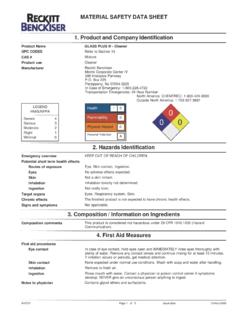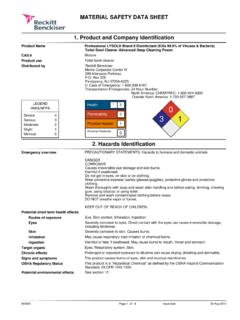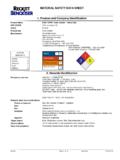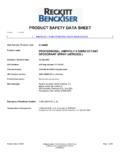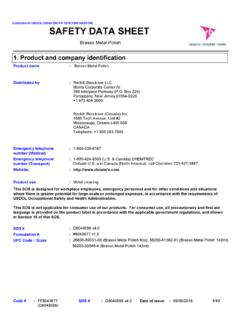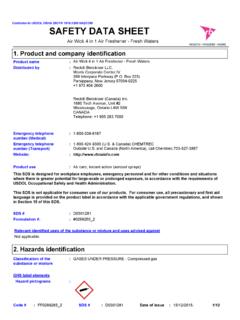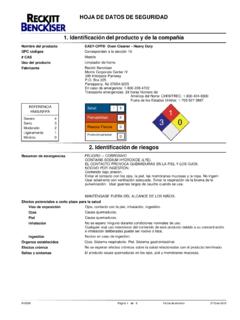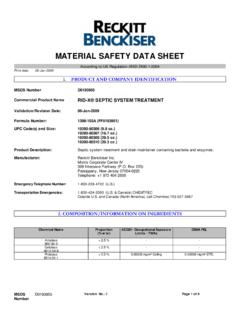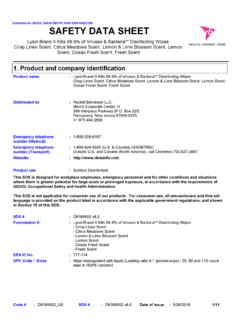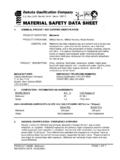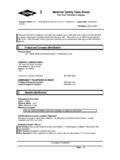Transcription of MATERIAL SAFETY DATA SHEET 1. Product and Company ...
1 MATERIAL SAFETY data SHEETP roduct Name LYSOL IC Disinfectant Spray (Aerosol).1. Product and Company IdentificationspaceUPC CODES Refer to Section 16spaceCAS # MixturespaceProduct use DisinfectantspaceDistributed byReckitt Benckiser Morris Corporate Center IV 399 Interpace Parkway Box 225 Parsippany, NJ 07054-0225 In Case of Emergency: 1-800-228-4722 Transportation Emergencies: 24 Hour Number: North America: CHEMTREC: 1-800-424-9300 Outside North America.
2 1-703-527-3887spacePersonal ProtectionPhysical HazardFlammabilityHealthA031/MinimalSlig htModerateSeriousLEGEND43210 Severe310 HMIS/NFPA spaceEmergency overviewThis Product is regulated by the US EPA as a STATEMENTS: Hazards to humans and domestic moderate eye irritation. Do not spray in eyes, on skin or on clothing. Washthoroughly with soap and water after handling and before eating, drinking, chewing gumor using HAZARDS: FLAMMABLECONTENTS UNDER away from heat, sparks and open flame. Do not puncture or incinerate to temperatures above 130 F may cause OUT OF REACH OF Hazards IdentificationspaceRoutes of exposurePotential short term health effectsEye, Skin contact, Inhalation, moderate eye expected during normal conditions of expected to be a skin expected during normal conditions of individuals may experience dizziness, drowsiness, nausea and vomiting ifexposed to extremely high concentrations of the of small quantities is not expected to cause any significant adverse organsBlood.
3 Eyes. Liver. Respiratory system. effectsThe finished Product is not expected to have chronic health and symptomsSymptoms may include redness, edema, drying, defatting and cracking of the of overexposure may be headache, dizziness, tiredness, nausea 1 of 8#2058020-Jul-2010 Issue dateCAS #Percent40 - 6064-17-5 Ingredient(s)Ethanol1 - 5106-97-8 Butane1 - 574-98-6 Propane0 - ApplicableAlkyl (50% C14, 40% C12, 10% C16) dimethyl benzyl ammonium Composition / Information on IngredientsspaceEye contactFirst aid proceduresHold eye open and rinse slowly and gently with water for 15-20 minutes. Remove contactlenses, if present, after the first 5 minutes, then continue rinsing eye.
4 Call a poisoncontrol center or doctor for treatment First Aid MeasuresspaceSkin contactIn keeping with good hygienic practices, wash exposed areas thoroughly with soap to fresh air. If irritation persists or there is any trouble breathing, get immediatemedical mouth and drink a glass of water. If symptoms persist, consult a physician. NEVER give an unconscious person anything to to physicianContains denatured ethanol; ingestion may result in ethanol poisoning. Symptoms maybe adviceDo not puncture or incinerate container. Keep away from sources of ignition. Nosmoking. If you feel unwell, seek medical advice (show the label where possible).
5 Ensurethat medical personnel are aware of the MATERIAL (s) involved, and take precautions toprotect themselves. Show this SAFETY data SHEET to the doctor in attendance. Avoidcontact with eyes and skin. Keep out of reach of the Product container or label with you when calling a poison control center ordoctor, or going for propertiesFlammable aerosol by flame projection flame extension: > 18 inches (45 cm).Containers may explode when Fire Fighting MeasuresspaceSuitable extinguishing mediaExtinguishing mediaWater spray. Foam. Dry chemical. Carbon extinguishing mediaNot availablespaceSpecific hazards arising fromthe chemicalProtection of firefightersContents under pressure.
6 Pressurized container may explode when exposed to heat orflame. Cool containers with flooding quantities of water until well after fire is equipment forfirefightersFirefighters should wear full protective clothing including self contained combustion productsMay include and are not limited to: Oxides of to mechanical impactExplosion dataNot availablespaceSensitivity to static dischargeNot availablespacePersonal precautionsKeep unnecessary personnel away. Do not touch or walk through spilled MATERIAL . Do nottouch damaged containers or spilled MATERIAL unless wearing appropriate protectiveclothing. Keep people away from and upwind of Accidental Release MeasuresspaceMethods for containmentEliminate all ignition sources (no smoking, flares, sparks, or flames in immediate area).
7 Stop leak if you can do so without risk. Prevent entry into waterways, sewers, basementsor confined for cleaning upBefore attempting clean up, refer to hazard data given above. Remove sources ofignition. Although the chance of a significant spill or leak is unlikely in aerosolcontainers, in the event of such an occurrence, absorb spilled MATERIAL with anon-flammable absorbent such as sand or 2 of 8#2058020-Jul-2010 Issue dateHandlingCAUTIONC auses moderate eye UNDER not spray in eyes, on skin or on clothing. When using do not eat or drink. Washhands before breaks and immediately after handling the replace cap after not use on polished wood, leather, rayon fabrics, or acrylic Handling and StoragespaceStorageStore in original container in areas inaccessible to small securely to temperatures above 130 F ( C) or in sun or discarding can in fire orincinerator may cause not contaminate water, food or feed by storage or away from heat, open flames or other sources of is a violation of Federal law to use this Product in a manner inconsistent with limitsIngredient(s)Alkyl (50% C14, 40% C12, 10% C16)
8 Dimethyl benzylammonium saccharinateExposure LimitsNot establishedACGIH-TLVOSHA-PELNot establishedButaneTWA: 1000 ppmACGIH-TLVOSHA-PELNot establishedEthanolTWA: 1000 ppmACGIH-TLVSTEL: 1000 ppmOSHA-PELTWA: 1000 ppmPropaneTWA: 1000 ppmACGIH-TLVOSHA-PELTWA: 1000 Exposure Controls / Personal ProtectionspaceEngineering controlsGeneral ventilation normally / face protectionPersonal protective equipmentNot normally required when used as directed. Avoid contact with responders should wear full eye and face protectionNot normally required when used as directed. Avoid contact with the responders should wear impermeable and body protectionAs required by employer protectionNot normally required if good ventilation is responders should wear self-contained breathing apparatus (SCBA) to avoidinhalation of vapours generated by this Product during a spill or other hygiene considerationsHandle in accordance with good industrial hygiene and SAFETY practice.
9 When using donot eat or with soap and water after use is recommended as good hygienic practice toprevent possible eye irritation from hand 3 of 8#2058020-Jul-2010 Issue Physical and Chemical PropertiesspaceColorClear, Slight yellowspaceFormMisty thresholdNot availablespacePhysical stateGasspacepH10 (Basic)spaceFreezing pointNot availablespaceBoiling pointNot availablespacePour pointNot availablespaceEvaporation rateNot availablespaceFlash pointNot availablespaceAuto-ignition temperatureNot availablespaceFlammability limits in air, lower, %by limits in air, upper, %by volume19spaceVapor pressure95 - 105 psigspaceVapor density> 1spaceSpecific @ 25 CspaceOctanol/water coefficientNot availablespaceSolubility (H2O)CompletespaceVOC (Weight %)
10 Not availablespaceViscosityNot availablespacePercent volatileNot availablespaceChemical stabilityStable under recommended storage Stability and ReactivityspaceConditions to avoidHeat, open flames, static discharge, sparks and other ignition sources. Aerosolcontainers are unstable at temperatures above 49 C ( F). Do not mix with decomposition productsMay include and are not limited to: Oxides of of hazardous reactionsHazardous polymerization does not analysis - LC50 Ingredient(s)Alkyl (50% C14, 40% C12, 10% C16) dimethyl benzylammonium saccharinateLC50 Not availableButane658 mg/l/4h ratEthanol31623 ppm ratPropaneNot Toxicological InformationspaceComponent analysis - Oral LD50 Ingredient(s)Alkyl (50% C14, 40% C12, 10% C16) dimethyl benzylammonium saccharinateLD50 Not availableButaneNot availableEthanol3450 mg/kg mouse.
